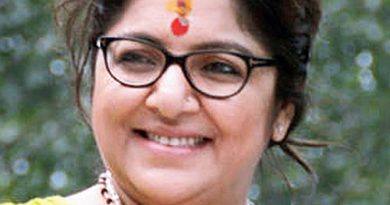| |
|---|
News Desk: Goddess Durga is being de-Hinduised and Hinduism distorted. This is what some outraged defenders of religion would want you to think of Pallab Bhaumik’s art form portraying the goddess in a migrant worker avatar, reflecting a woman who lost her job in the lockdown and walked home for days.

What the new flag-bearers of Hindutva don’t understand is that people in West Bengal have bridged the gap between tradition and art long ago, and are all the richer for it. Hinduism in West Bengal does not need defending. For Bengalis, creativity is part of worship and religion doesn’t begin in temples but in people’s emotional expressions.
The idol of goddess Durga in a sari carrying a shirtless baby in her arms became an overnight internet sensation. Sculpted by Kolkata artist Pallab Bhaumik, the idol, made for Barisha Club Durga Puja committee, highlighted the plight of the migrant workers, who were forced to walk thousands of kilometres to reach home from cities amid the Covid-induced lockdown.
The conceptualisation of goddess Durga in the form of a migrant worker was hailed by many on social media for bringing to the fore the hardships and the struggles of thousands of migrant labourers, who were left with no jobs or money after the lockdown, forcing them to take long and painful walks back home.
But not all were impressed. Many called the idol a “distortion”, an attempt to “de-Hinduise and de-fang Durga”, “conspiracy to destroy Sanatan Dharma”, and “making mockery of Hinduism”.
Those outraging over the idol’s depiction must educate themselves about Bengal’s culture of celebrating Durga Puja.
Goddess Durga, for long, has been worshipped in different forms in Bengal — as transgender Durga, where she was modelled on ‘Ardhanarishwar’, the androgynous form of Lord Shiva and his wife Parvati; as Barbie Durga; as mother nature, or as the traditional ‘ekchala’ (single backdrop) idol sporting big, wide eyes on a heart-shaped face.
The state has also worshipped Durga idols made of chocolate as well as spices, wheat, pencil and more.
The ‘migrant’ Durga idol is just another example of such artistic expression.
When it comes to depicting art through Durga idols and pandals, West Bengal never imposed boundaries. In fact, it is also through the Puja that the state has been promoting and celebrating art since times immemorial — whether it is ‘theme’ pujas, pandal illuminations/lightings or idol installations.
Bengalis never considered innovations with Durga idols as a breach of tradition, let alone calling it an attack on Hinduism.
We never stuck to the traditional form, and have always viewed innovations and experimentations as work of art modelled by artists whose genius manifested itself in idols and pandals.
Probably, that is why Bengal’s Durga Puja has evolved to become a socio-cultural celebration, rather than a religious festival.
Artist Rintu Das, who conceptualised the ‘migrant’ Durga idols, said he wanted to portray the “strength and determination” of goddess Durga in the migrant woman.
This is in sync with the traditional image of the goddess, which is that of a fierce woman with ten hands, slaying the demon ‘Mahishasura’.
The image of goddess Durga as a poor migrant worker can be, therefore, looked upon as being symbolic of the power of a mother.
It highlights the strength of thousands of poor migrant mothers, who walked back to their native villages carrying their toddlers, braving the scorching heat, hunger and thirst. Goddess Durga is symbolic of such immense resolve, grit and determination.
The ‘migrant’ Durga idol isn’t the first to offend self-proclaimed Hindutva warriors. In 2017, noted hair stylist Jawed Habib was accused of hurting religious sentiments for featuring goddess Durga in an advertisement showing her at a Habib’s salon.
In both the cases, the outrage seems to have come largely from outside West Bengal.
The outrage brigade must know that goddess Durga and her children (Lakshmi, Ganesh, Karthik and Saraswati) have been humanised in Bengal over the years. And this is also primarily one of the reasons why Durga idols can be presented in different artistic forms, be it as a migrant worker or someone else.
Humanisation of Durga and her children has much to do with how Bengalis view them. Durga is not just a goddess to Bengalis, but is also considered as the daughter of the house, who is believed to leave her sasural in Mount Kailash every year to visit her maternal home on Earth with her children for five days, just like the homecoming of a married daughter.
It is, therefore, pointless to waste time on those who have no idea about how Bengal worships goddess Durga. They may even have an ulterior motive to ‘manufacture’ outrage, considering how reminding people about the hardships that migrant workers faced is not something a section of the political class would like.
West Bengal will continue to celebrate and worship Durga in her various avatars and forms. And there can be no better way to celebrate Durga Puja than to laud the beauty and spirit of women — migrant or otherwise.




